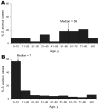Community strains of methicillin-resistant Staphylococcus aureus as potential cause of healthcare-associated infections, Uruguay, 2002-2004
- PMID: 18680644
- PMCID: PMC2600392
- DOI: 10.3201/eid1408.071183
Community strains of methicillin-resistant Staphylococcus aureus as potential cause of healthcare-associated infections, Uruguay, 2002-2004
Abstract
Community-associated MRSA (CA-MRSA) strains have emerged in Uruguay. We reviewed Staphylococcus aureus isolates from a large healthcare facility in Montevideo (center A) and obtained information from 3 additional hospitals on patients infected with CA-MRSA. An infection was defined as healthcare-onset if the culture was obtained >48 hours after hospital admission. At center A, the proportion of S. aureus infections caused by CA-MRSA increased from 4% to 23% over 2 years; the proportion caused by healthcare-associated MRSA (HA-MRSA) decreased from 25% to 5%. Of 182 patients infected with CA-MRSA, 38 (21%) had healthcare-onset infections. Pulsed-field gel electrophoresis determined that 22 (92%) of 24 isolates were USA1100, a community strain. CA-MRSA has emerged in Uruguay and appears to have replaced HA-MRSA strains at 1 healthcare facility. In addition, CA-MRSA appears to cause healthcare-onset infections, a finding that emphasizes the need for infection control measures to prevent transmission within healthcare settings.
Figures



References
-
- Klevens RM, Edwards JR, Tenover FC, McDonald LC, Horan T, Gaynes R; National Nosocomial Infections Surveillance System. Changes in the epidemiology of methicillin-resistant Staphylococcus aureus in intensive care units in US hospitals, 1992–2003. Clin Infect Dis. 2006;42:389–91. 10.1086/499367 - DOI - PubMed
-
- Thompson RL, Cabezudo I, Wenzel RP. Epidemiology of nosocomial infections caused by methicillin-resistant Staphylococcus aureus. Ann Intern Med. 1982;97:309–17. - PubMed
-
- Boyce JM. Methicillin-resistant Staphylococcus aureus: detection, epidemiology, and control measures. Infect Dis Clin North Am. 1989;3:901–13. - PubMed
MeSH terms
LinkOut - more resources
Full Text Sources
Medical
